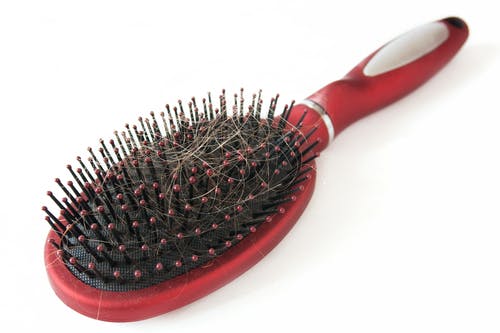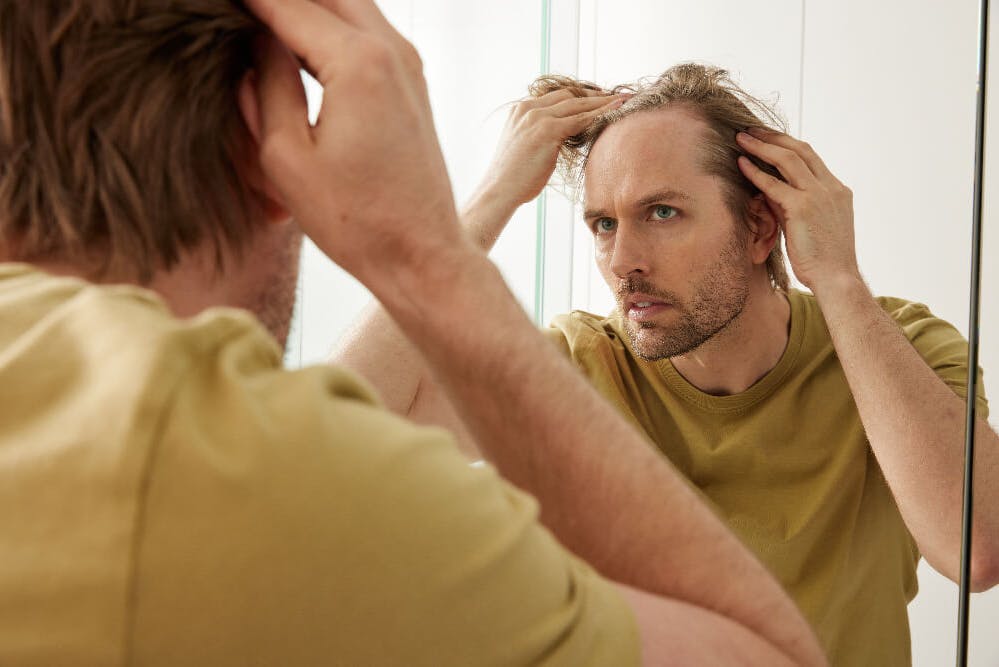


Losing between 50 to 100 hairs per day is considered normal [1], but when you start noticing excessive hair shedding, it can be alarming. Many individuals experiencing hair loss turn to treatments like minoxidil or prescription medications, only to encounter the so-called "dread shed"—a temporary increase in hair shedding [2]. In this article, we'll explore why treatments like minoxidil causes shedding [3], how to manage the shedding phase, and how Mosh can help you combat hair loss effectively.
Hair growth occurs in cycles and involves four main phases [4]:
At any given time, each hair follicle is at a different stage of this hair growth cycle, which is why normal hair shedding happens daily.
Several factors can disrupt the normal hair cycle, leading to increased hair shedding [5]:
Topical minoxidil is a treatment approved for hair loss disorders [3]. Originally developed as an oral medication for high blood pressure, minoxidil was found to have the side effect of promoting hair growth. Today, it is widely used in both topical minoxidil and low-dose oral minoxidil forms to treat hair loss.
Minoxidil stimulates hair follicles by prolonging the anagen phase and increasing blood flow to the scalp [6]. This encourages thicker, stronger hair growth over time. Studies have shown that individuals using 5% topical minoxidil experienced 45% more hair regrowth compared to those using the 2% formulation after 48 weeks [7].
In addition to topical treatments, there are hair regrowth prescription medications available that address hair loss by targeting hormonal factors contributing to androgenetic alopecia. These treatments are effective for both male and female pattern hair loss and work by inhibiting the formation of dihydrotestosterone (DHT), a hormone linked to hair thinning and loss [8].

The "dread shed" refers to the temporary increase in hair shedding that some minoxidil and hair loss medication users experience when they first start treatment for hair loss [2]. While it may seem counterintuitive, this shedding is a sign that the treatment is working.
Both topical minoxidil and certain prescription medications can cause an initial increase in hair shedding, known as the dread shed. This occurs because these treatments accelerate the hair growth cycle, pushing hairs from the telogen phase into the exogen phase sooner than usual. This makes way for new, healthier hairs to grow during the anagen phase [9].
When minoxidil is applied to the scalp, it sends a signal to all the hairs waiting in line to shed [9]. The message is that they no longer need to wait the usual 2-3 months. Any hair that is in line to shed is now encouraged to shed immediately. The typical waiting period has been temporarily lifted. As a result, the person experiences an increased amount of hairs falling out on a daily basis after starting minoxidil. What is being shed are hairs that were destined to come out anyway:
The shedding timeline typically occurs within the first 2 to 8 weeks of starting minoxidil treatment for hair loss (or other treatments) and should subside as the hair follicles adjust, although for some who experience a temporary increase in hair shed, shedding may continue for a little longer [10]. It's important to continue maintaining the use of your treatment as directed by your practitioner, as stopping could reverse any progress made [11]. If you continue to experience increased shedding beyond four months, consult a healthcare professional to rule out other causes.
While experiencing increased shedding can be unsettling, it's actually a sign that the minoxidil treatment or your prescribed hair treatment is working. The old hairs are being shed to allow for the growth of new, healthier hair. The hair you lose during the shedding process always grows back [11].
All formulations of minoxidil have the potential to cause shedding, though not all people may experience this short-term issue [11]. The amount of hair shedding may vary from person to person. Some individuals might experience only minimal shedding when starting minoxidil or their hair loss treatment, while others might notice more significant excess shedding. It's essential to understand that this variation is normal and part of the process.
Many patients experienced dread shed as a common side effect when starting minoxidil treatment, but it's imperative you don't stop using minoxidil immediately if you've just started. Knowing that others have gone through the same process can be reassuring. Remember that shedding happens as a natural part of the hair growth cycle and is expected when using minoxidil. Staying consistent with your treatment use is crucial for achieving the desired results in hair regrowth.
Understanding the type of hair loss you're experiencing can help in selecting the most effective treatment.
A form of temporary hair shedding often triggered by stress, illness, or hormonal changes [12].
A genetic condition characterised by a receding hairline and thinning at the crown in men (male pattern baldness), and overall thinning in women (female pattern hair loss) [13].
An autoimmune disorder causing patchy hair loss on the scalp, face, and body [14]. Sometimes, alopecia areata sufferers experience spontaneous regrowth of their hair in patches since the follicles are not completely destroyed. Some extreme cases may even cause total shedding all over.
Inflammation destroys hair follicles, leading to permanent hair loss [15].
For those who are experiencing minoxidil shedding, it's important to:
Experiencing the dread shed can be unsettling, but understanding why it happens can alleviate concerns. Shedding is a temporary increase in hair loss—a normal part of the hair growth cycle when starting treatments like topical minoxidil or prescription medications. With the right support and treatment plan from Mosh, you can navigate this shedding phase confidently and look forward to new hair growth.












Ready to Treat Hair Loss?